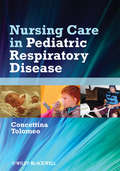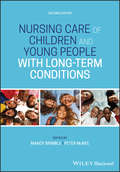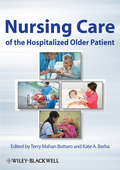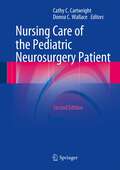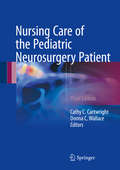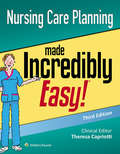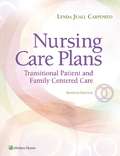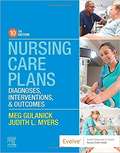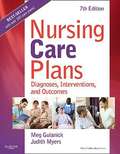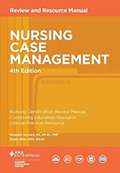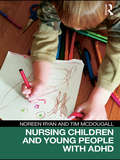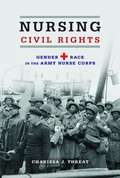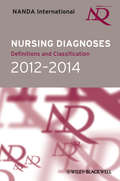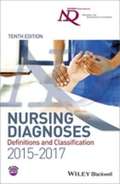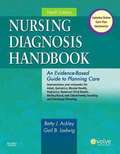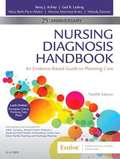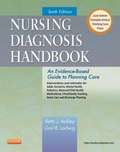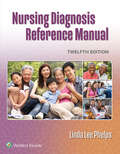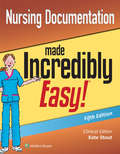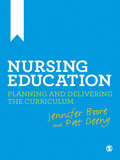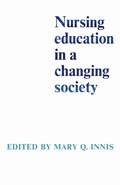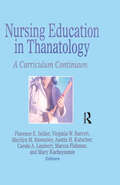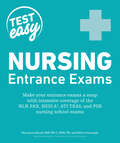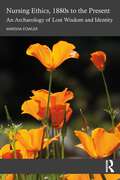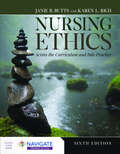- Table View
- List View
Nursing Care in Pediatric Respiratory Disease
by Concettina TolomeoPediatric respiratory disorders are responsible for a number of acute and chronic health conditions and are a leading cause of pediatric emergency room visits and hospitalizations. More than ever, nurses and nurse practitioners must have an understanding of the anatomy, pathophysiology, diagnosis and state of the art treatments in pediatric respiratory disease as they are often the first to come in contact with and recognize respiratory problems in children. Nursing Care in Pediatric Respiratory Disease seeks to provide both nurses and nurse practitioners with this information in order to aid them in the diagnosis and treatment of children suffering from acute and chronic respiratory disorders.Nursing Care in Pediatric Respiratory Disease opens with an overview of the anatomy and physiology of the respiratory system, best practices for assessing respiratory symptoms in children, and common respiratory therapies and treatment methods. It then proceeds through an examination of varying acute and chronic upper and lower respiratory diseases spanning from asthma and cystic fibrosis to vocal cord paralysis and sinusitis in both hospital and ambulatory settings.Nursing Care in Pediatric Respiratory Disease provides nurses and other health care providers with a comprehensive and practical resource which allows them to collaborate and advocate more effectively, as well as educate both the family and child in management of respiratory disorders.
Nursing Care of Children and Young People with Long-Term Conditions
by Mandy Brimble Peter McNEEThe second edition of Nursing Care of Children and Young People with Long Term Conditions remains the only nursing-specific text on the care of paediatric patients with chronic illness. Written to meet the needs of nursing students and professionals alike, this comprehensive volume provides authoritative and up-to-date information on the context, theory, and practice of delivering holistic care to children and families in a range of health and social care settings. Contributions from a team of experienced academics, educators, and practitioners offer valuable insight into the impact of chronic illness on children and parents, the practical implications of meeting their physical, psychological, and social needs, empowering them to be ‘experts’ in their care, and many more vital aspects of long-term paediatric care. This edition features new and revised content reflecting contemporary guidelines and evidence-based practice, including updated clinical case studies and a new chapter examining the impact of having a sibling with a long-term condition. Emphasising a multi-disciplinary approach to managing chronic illness, this important resource: Provides numerous case studies and activities illustrating the application of theoretical principles and current evidence in nursing practice Investigates the genetic basis of chronic illness and the differing onsets of long-term conditions Discusses current political, economic, and social policies that are influencing healthcare for children and bringing challenges to managers and practitioners Examines both classic and contemporary theories of grief, loss, coping, and adaptation Explores ethical, legal, and professional aspects of nursing children and young people with chronic illness Addresses evolving nursing roles, the importance of acute emergency care, and the planning and delivery of effective tra
Nursing Care of the Hospitalized Older Patient
by Terry Mahan Buttaro Kate A. BarbaNursing Care for the Hospitalized Older Patient is a comprehensive, quick-reference resource for registered and advanced practice nurses working with older patients in a hospital setting. Organized in user-friendly format, the book provides vital information on all aspects of hospital care and the full range of health issues encountered by elderly patients. The book is organized into four major sections. The first section provides an overview of the aging patient, including demographics, normal aging changes, and the general impact of hospitalization. The second section covers proper health assessment, providing guidance on history taking and evaluating laboratory values. The third section is the largest part of the book and is made up of short, similarly-structured chapters dedicated to individual clinical issues ranging from burns to depression. These chapters are organized by body system to maximize ease of use. The book concludes with a section on special considerations that cross common clinical areas, such as palliative care, pain management, fall prevention, and discharge planning.
Nursing Care of the Pediatric Neurosurgery Patient
by Cathy C. Cartwright Donna C. WallaceNursing Care of the Pediatric Neurosurgery Patient is a detailed reference for nurses and other health care providers who care for children with neurosurgical problems. The explanations of pathophysiology, anatomy, radiodiagnostic testing, and treatment options for each neurosurgical diagnosis will help to clarify the rationale behind the nursing care. Descriptions of presenting symptoms, history and findings on neurological examination will help nurses understand the neurological disorder and identify problems. Each chapter includes case studies, impact on families, patient and family education, and practice pearls. Staff and student nurses working in clinics, critical care units, pediatric units, operating rooms, post-anesthesia care units, emergency departments, and radiology departments will benefit from the information presented. Although this book is written for nurses, medical students and neurosurgery residents will also find it helpful.
Nursing Care of the Pediatric Neurosurgery Patient
by Cathy C. Cartwright Donna C. WallaceThis updated third edition is a detailed reference for nurses and other health care providers who care for children with neurosurgical conditions. The explanations of pathophysiology, anatomy, neurodiagnostic imaging, and treatment options for each neurosurgical diagnosis will help to clarify the rationale behind the nursing care. Descriptions of presenting symptoms, history and findings on neurological examination will help nurses understand the neurological disorder and identify problems. New chapters have been added on skull and scalp anomalies, pediatric concussion, abuse head trauma and on neuroimaging. Each chapter includes case studies, impact on families, patient and family education, and practice pearls. Staff and student nurses working in clinics, critical care units, pediatric units, operating rooms, post-anesthesia care units, emergency departments, and radiology departments will benefit from the information presented. Although this book is written for nurses, child life therapists, physical and occupational therapists, medical students and neurosurgery residents will also find it helpful. Parents of children with neurosurgical disorders will also find it a useful resource in understanding their child's condition.
Nursing Care Planning Made Incredibly Easy! (Incredibly Easy! Series®)
by Lippincott Williams WilkinsGet clear on nursing care planning and map the way to positive outcomes—in the classroom and in clinical practice—with the thoroughly updated Nursing Care Planning Made Incredibly Easy!®, 3rd Edition. Learn step-by-step how to build a concept map, develop a nursing diagnosis, and choose realistic outcomes and individualized interventions. This nursing guide leads you expertly through the care plan process, backed by the Made Incredibly Easy series’ trademark humor, plentiful illustrations, and down-to-earth explanations. Master the concepts and process of care planning … NEWand updated guidance on following the evidence-based standards of North American Nursing Diagnosis Association (NANDA) diagnoses, and Nursing Outcomes Classification (NOC) and Nursing Interventions Classification (NIC) guidelines Nursing Outcomes Classification (NOC), and Nursing Interventions Classification (NIC) guidelines NEWfull-color design—dozens of illustrations and diagrams that outline the process of concept mapping, diagramming, and intervention planning NEW guidance on creating electronic plans—online access to 166 customizable care plans covering every nursing specialty, including new plans for gastric bypass, preterm labor, and cerebral palsy, plus examples of handwritten care plans NEW Nurse Joy and Jake offer practical advice throughout Breaks down the process of creating individualized care plans into easy-to-follow segments Guides nursing students and new nurses into the critical thinking and planning skills needed to choose appropriate, effective treatments and interventions Case study exercises and clinical tips to help you integrate care plan concepts and evidence-based standards with real-life situations Part Idiscusses NANDA-I, NOC, and NIC—covers assessment, nursing diagnosis, planning, implementation, evaluation, and integrating the concepts Part II integrates major nursing diagnoseswith common medical diagnoses—addresses medical-surgical, maternal-neonatal, pediatric, and psychiatric diagnoses Chapter features include: Just the facts—quick summary of chapter content Under construction—sample concept maps and care plan components, with tips for creating individualized care plans On the case—visual, step-by-step instruction applied to real-life patient care scenarios Weighing the evidence—the latest evidence-based standards of care, demonstrated in sample care plans Teacher knowsbest—helpful tips and reminders to help you apply what you are learning Memory jogger—techniques for remembering vital content
Nursing Care Plans: Transitional Patient & Family Centered Care
by Lynda J. CarpenitoLearn how to create nursing care plans and effectively document care with Nursing Care Plans: Transitional Patient and Family Centered Care, Seventh Edition. This book focuses on the most important nursing plans, including specialty care plans, ensuring that students learn what they need to know, and develop an understanding of the importance of evidence-based practice through evidence-based rationales and guidelines.
Nursing Care Plans: Diagnoses, Interventions, And Outcomes
by Meg Gulanick Judith L. MyersGet everything you need to create and customize effective nursing care plans, now with evidence-based ICNP® diagnoses! Covering the most common medical-surgical nursing diagnoses and clinical problems, Gulanick & Myers’ Nursing Care Plans: Diagnoses, Interventions, and Outcomes, 10th Edition features more than 200 care plans, each reflecting the latest evidence-based guidelines and national and international treatment protocols. It also features highlighted QSEN competencies and a clear differentiation of nursing and collaborative interventions. New to this edition are ICNP® diagnoses, care plans on LGBTQ health issues and on electrolytes and acid-base balance, and a new Online Care Planner that makes it easier than ever to customize care plans. Written by noted educators Meg Gulanick and Judith L. Myers, this #1 care planning book will help you learn to think like a nurse!
Nursing Care Plans (Seventh Edition): Diagnoses, Interventions, and Outcomes
by Meg Gulanick Judith L. MyersOur primary goal for this edition of Nursing Care Plans: Diagnoses, Interventions, and Outcomes has been to build on the quality of the premier resource used by nurses to plan care for an increasingly diverse population of patients. This work is the most comprehensive care planning book on the market, with over 200 care plans covering the most common nursing diagnoses and clinical problems in medical-surgical nursing patients.
Nursing Case Management Review And Resource Manual
by Margaret Leonard Elaine MillerWritten by nursing experts in case management, this book provides a clinical reference tool and continuing education contact hours. This manual helps readers enhance critical thinking skills and identify strengths and weaknesses. This manual contains an addendum, which includes information from the revised test content outline to ensure the manual is up to date. This additional information will assist you with successful study for the certification exam and may be used as a guideline for your practice.
Nursing Children and Young People with ADHD
by Noreen Ryan Tim McDougallADHD is one of the most commonly diagnosed behavioural disorders in children and young people. It is a complex and contested condition, with potential causes and treatments in biological, psychological and social domains. This is the first comprehensive text for nurses and other health professionals in this field. Nursing Children and Young People with ADHD explores the evidence, incorporating and expanding on the new NICE guidelines for practice in this area, to provide an essential knowledge base for practice. The text covers: causes, diagnosis, co-morbidity, user and carer perspectives, assessment, treatment and interventions (including those suitable for use in schools), prescribing and the legal background. An invaluable text for pre-registration student nurses on mental health and children branches, this will also be a useful reference work for post-registration nurses and health professionals seeking evidence-based recommendations for practice.
Nursing Civil Rights: Gender and Race in the Army Nurse Corps (Women, Gender, and Sexuality in American History)
by Charissa J. ThreatIn Nursing Civil Rights, Charissa J. Threat investigates the parallel battles against occupational segregation by African American women and white men in the U.S. Army. As Threat reveals, both groups viewed their circumstances with the Army Nurse Corps as a civil rights matter. Each conducted separate integration campaigns to end the discrimination they suffered. Yet their stories defy the narrative that civil rights struggles inevitably arced toward social justice. Threat tells how progressive elements in the campaigns did indeed break down barriers in both military and civilian nursing. At the same time, she follows conservative threads to portray how some of the women who succeeded as agents of change became defenders of exclusionary practices when men sought military nursing careers. The ironic result was a struggle that simultaneously confronted and reaffirmed the social hierarchies that nurtured discrimination.
Nursing Diagnoses
by NANDA InternationalA nursing diagnosis is defined as a clinical judgment about individual, family or community responses to actual or potential health problems or life processes which provide the basis for selection of nursing interventions to achieve outcomes for which the nurse has accountability (NANDA-I, 2009). Accurate and valid nursing diagnoses guide the selection of interventions that are likely to produce the desired treatment effects and determine nurse-sensitive outcomes.Nursing diagnoses are seen as key to the future of evidence-based, professionally-led nursing care - and to more effectively meeting the need of patients. In an era of increasing electronic patient health records, standardized nursing terminologies such as NANDA-I, NIC and NOC provide a means of collecting nursing data that are systematically analysed within and across healthcare organizations and provide essential data for cost/benefit analysis and clinical audit.Nursing Diagnoses: Definitions and Classification is the definitive guide to nursing diagnoses, as reviewed and approved by NANDA-I. Each nursing diagnosis undergoes a rigorous assessment process by NANDA-I's Diagnosis Development Committee, with stringent criteria used to indicate the strength of the underlying level of evidence.Each diagnosis comprises a label or name for the diagnosis, a definition, defining characteristics, risk factors and/or related factors. Many diagnoses are further qualified by terms such as risk for, effective, ineffective, impaired, imbalanced, self-care deficit, readiness for, disturbed, decreased, etc.The 2012-2014 edition is arranged by concept according to Taxonomy II domains, i.e. Health promotion, Nutrition, Elimination and exchange, Activity/Rest, Perception/Cognition, Self-perception, Role relationships, Sexuality, Coping/ Stress tolerance, Life principles, Safety/protection, Comfort, and Growth/development.The 2012-2014 edition contains revised chapters on NANDA-I taxonomy, and slotting of diagnoses into NANDA & NNN taxonomies, diagnostic reasoning & conceptual clarity, and submission of new/revised diagnoses. New chapters are provided on the use of nursing diagnoses in education, clinical practice, electronic health records, nursing & health care administration, and research . A companion website hosts related resources.Key features2012-2014 edition arranged by diagnostic conceptsCore references and level of evidence for each diagnosisNew chapters on appropriate use of nursing diagnoses in clinical practice, education, administration and electronic health record16 new diagnoses11 revised diagnosesAimed at students, educators, clinicians, nurse administrators and informaticiansCompanion website available, including a video on assessment, clinical reasoning and diagnosis
Nursing Diagnoses 2015-17
by NANDA InternationalNursing Diagnoses: Definitions and Classification is the definitive guide to nursing diagnoses, as reviewed and approved by NANDA-I. The 2015-2017 edition of the classic and internationally recognised text has been rigorously updated and revised, and now provides more linguistically congruent diagnoses as a result of the Diagnostic Development Committee's attentiveness to understanding the translation of the diagnostic label, definition, defining characteristics, related factors, and risk factors. Each of the 235 diagnoses presented are supported by definitions as well as defining characteristics and related factors, or risk factors. Each new and revised diagnosis is based on the latest global evidence, and approved by expert nurse diagnosticians, researchers, and educators.New to this edition:26 brand new nursing diagnoses and 13 revised diagnosesUpdates, changes, and revision to the vast majority of the nursing diagnosis definitions, in particular the Health Promotion and Risk DiagnosesA standardization of diagnostic indicator terms (defining characteristics, related factors, and risk factors) to further aid clarity for readers and cliniciansAll introductory chapters are written at an undergraduate nursing level, and provide critical information needed for nurses to understand assessment, its link to diagnosis, and the purpose and use of taxonomic structure for the nurse at the bedsideA new chapter, focusing on Frequently Asked Questions, representing the most common questions received through the NANDA-I website, and at global conferencesFive nursing diagnoses have been re-slotted within the NANDA-I taxonomy, following a review of the current taxonomic structureCoding of all diagnostic indicator terms is now available for those using electronic versions of the terminologyCompanion website featuring references from the book, video presentations, teaching tips, and links to taxonomy history and diagnosis submission/review process description www.wiley.com/go/nursingdiagnoses
Nursing Diagnosis Handbook: An Evidence-based Guide to Planning Care (9th Edition)
by Betty J. Ackley Gail B. LadwigThis edition shows you how to build customized care plans using a three-step process: assess, diagnose, and plan care. It includes suggested nursing diagnoses for over 1,300 client symptoms, medical and psychiatric diagnoses, diagnostic procedures, surgical interventions, and clinical states.
Nursing Diagnosis Handbook: An Evidence-based Guide to Planning Care
by Betty J. Ackley Gail B. Ladwig Mary Beth Flynn Makic Marina Reyna Martinez-Kratz Melody ZanottiThis convenient handbook shows you how to correlate nursing diagnoses with known information about clients on the basis of assessment findings, established medical or psychiatric diagnoses, and the current treatment plan. Extensively revised and updated with the new 2018-2020 NANDA-I approved nursing diagnoses, it integrates the NIC and NOC taxonomies, evidence-based nursing interventions, and adult, pediatric, geriatric, multicultural, home care, safety, and client/family teaching and discharge planning considerations to guide students in creating unique, individualized care plans.
Nursing Diagnosis Handbook: An Evidence-Based Guide to Planning Care (10th Edition)
by Gail B. Ladwig Betty J. AckleyThe 10th edition of the Nursing Diagnosis Handbook makes formulating nursing diagnoses and creating individualized care plans a breeze. Updated with the most recent NANDA-I approved nursing diagnoses, this convenient reference shows you how to build customized care plans in three easy steps: assess, diagnose, plan. Authors Elizabeth Ackley and Gail Ladwig use Nursing Outcomes Classification (NOC) and Nursing Interventions Classification (NIC) to guide you in creating care plans that include desired outcomes, interventions, patient teaching, and evidence-based rationales. Unique! Care Plan Constructor on the companion Evolve website offers hands-on practice creating customized plans of care. Alphabetical thumb tabs allow quick access to specific symptoms and nursing diagnoses.Suggested NIC interventions and NOC outcomes in each care plan. Recent and classic research examples promote evidence-based interventions and rationales. NEW! 4 Color textNEW! Includes updated 2012-2014 NANDA-I approved nursing diagnosesNEW! Provides the latest NIC/NOC, interventions, and rationales for every care plan.NEW! QSEN Safety interventions and rationalesNEW! 100 NCLEX exam-style review questions are available on the companion Evolve website.NEW! Root Causing Thinking and Motivational Interviewing appendixes on the companion Evolve website.
Nursing Diagnosis Reference Manual
by Linda PhelpsBoost students’ clinical confidence and practice readiness with the latest evidence-based information for nursing diagnoses. Nursing Diagnosis Reference Manual, 12th Edition, provides fast, efficient access to clearly written, comprehensive coverage of the 2021-2023 NANDA-I definitions and classifications to help students meet the evolving healthcare needs of today’s patients. Approachable monographs—thoroughly updated and alphabetized for quick, easy reference—reflect the nursing process and the expertise of leading nursing clinicians, educators, and researchers to equip students for clinical success in any setting.
Nursing Documentation Made Incredibly Easy (Incredibly Easy! Series®)
by Kate StoutPublisher's Note: Products purchased from 3rd Party sellers are not guaranteed by the Publisher for quality, authenticity, or access to any online entitlements included with the product. Feeling unsure about the ins and outs of charting? Grasp the essential basics, with the irreplaceable Nursing Documentation Made Incredibly Easy!®, 5th Edition. Packed with colorful images and clear-as-day guidance, this friendly reference guides you through meeting documentation requirements, working with electronic medical records systems, complying with legal requirements, following care planning guidelines, and more. Whether you are a nursing student or a new or experienced nurse, this on-the-spot study and clinical guide is your ticket to ensuring your charting is timely, accurate, and watertight. Let the experts walk you through up-to-date best practices for nursing documentation, with: NEW and updated, fully illustrated content in quick-read, bulleted format NEWdiscussion of the necessary documentation process outside of charting—informed consent, advanced directives, medication reconciliation Easy-to-retain guidance on using the electronic medical records / electronic health records (EMR/EHR) documentation systems, and required charting and documentation practices Easy-to-read, easy-to-remember content that provides helpful charting examples demonstrating what to document in different patient situations, while addressing the different styles of charting Outlines the Do's and Don’ts of charting – a common sense approach that addresses a wide range of topics, including: Documentation and the nursing process—assessment, nursing diagnosis, planning care/outcomes, implementation, evaluation Documenting the patient’s health history and physical examination The Joint Commission standards for assessment Patient rights and safety Care plan guidelines Enhancing documentation Avoiding legal problems Documenting procedures Documentation practices in a variety of settings—acute care, home healthcare, and long-term care Documenting special situations—release of patient information after death, nonreleasable information, searching for contraband, documenting inappropriate behavior Special features include: Just the facts – a quick summary of each chapter’s content Advice from the experts – seasoned input on vital charting skills, such as interviewing the patient, writing outcome standards, creating top-notch care plans “Nurse Joy” and “Jake” – expert insights on the nursing process and problem-solving That’s a wrap! – a review of the topics covered in that chapter About the Clinical Editor Kate Stout, RN, MSN, is a Post Anesthesia Care Staff Nurse at Dosher Memorial Hospital in Southport, North Carolina.
Nursing Education: Planning and Delivering the Curriculum
by Jennifer Boore Patrick DeenyNursing Education provides a strategic guide and practical focus to curriculum planning and development. It will help all those involved in the provision of nursing education to understand the issues involved at the different stages of preparing a nursing curriculum which: - meets both professional and academic requirements; - integrates theory and practice; - enables students to achieve the skills and competencies they need for professional practice; - includes different methods of teaching and learning; - provides clear guidance for student selection and assessment. Balancing theoretical principles with practical application, and linked closely to the NMC's 2010 standards for pre-registration nursing, Jennifer Boore and Pat Deeny illustrate clearly and accessibly how to develop tailored education programmes so that nurse educators and clinicians in practice can enable their students to provide up-to-date and appropriate patient care.
Nursing Education in a Changing Society
by Mary InnisRapid social change and the advances made in the field of health care have greatly changed the role and function of the nurse in the last fifty years. Nursing is now almost a full-fledged profession. This book celebrates the fiftieth anniversary of the School of Nursing of the University of Toronto. The field it covers is wide and varied – from care of the sick by the nuns of early Quebec to the development of pre-paid nursing plans, from concepts of "beside nursing" to "delivery health services." There are long looks into the future of nursing education and health care which include descriptions of health science centres, diagnosis by computer, and treatment centres in outer space. The book sketches the history of this pioneer school of nursing, surveys nursing legislation, and examines the rise of the public-health nurse and the nursing assistant. Essays contributed by leading Canadian authorities show a wide range of opinion: one writer wants to see the scope of nursing education enlarged, another thinks it is too broad already. At a time when nursing education is becoming an increasingly controversial subject, this book will be of interest and value to all those in the health field.
Nursing Education in Thanatology: A Curriculum Continuum
by Austin H. Kutscher Florence E. Selder Virginia W. Barrett Marilyn M. Rawnsley Carole A. Lambert Marcia Fishman Mary KachoyeanosNursing Education in Thanatology is an excellent source book for planning thanatology courses or for integrating concepts of thanatology into a nursing curriculum. As the formal teaching of thanatology in schools for health care professionals is generally overlooked and ill-defined, many students and professionals will learn to deal with dying and grieving upon their first encounter with death. This practical book will aid educators in planned inclusion of thanatology in curriculum to insure the preparedness of health care professionals in assisting patients and/or their families during an emotionally difficult period. There are many suggestions presented for beneficial methods of integrating thanatology education into existing courses or offering thanatology as a single course for education professionals.A vital resource for inservice coordinators working with clinicians in oncology, hospital staff, and health professionals in community or outpatient health centers, Nursing Education in Thanatology is excellent reading for helping professionals working with elderly people.
Nursing Entrance Exams (Test Easy)
by Maryanne Baudo Robin KavanaghRest Easy with Test Easy!You're excited about your decision to pursue a career in nursing. And regardless of what type of nurse you plan to become--RN, LPN or LVN, CNS, nurse practitioner, or other specialization--you know that to get into the nursing program of your choice you'll have to do your absolute best on the entrance exams. Well, rest easy because Test Easy makes acing your exams a snap! In this book, you get:An overview of the NLN PAX, HESI, ATI TEAS, HOBET, and PSB Nursing School ExamsTips for boosting your grammar, vocabulary, and reading proficiency to pass the nursing exam verbal sectionMath essentials to get you comfortable with the arithmetic, algebra, and geometry nurses need to knowScience tutorials for boning up on the essentials of life science, anatomy & physiology, chemistry, and physicsPractice exams to test your progress, plus detailed answers to help you pass your exams with flying colors
Nursing Ethics, 1880s to the Present: An Archaeology of Lost Wisdom and Identity
by Marsha FowlerThis important text draws on decades of research, arguing that modern nursing germinated and grew an ethics from its own native soil, which is rich, fulsome, and philosophically informed, grounded in the tradition and practice of nursing.It is an ethics with a positive agenda for the good nurse, a good society, a healthy people, and human flourishing. This native nursing ethics was forgotten, creating space for a foreign bioethics’ colonization of nursing in the second half of the twentieth century. Drawing from a wide range of sources from the USA, the UK, Canada, and Ireland, the book addresses the early and enduring ethical concerns, values, and ideals of nursing as a profession that engages in direct clinical practice and in developing policy. Fowler calls for reclaiming and renewing nursing’s ethical tradition.This systematic and comprehensive book is an essential contribution for students and scholars of nursing ethics.
Nursing Ethics: Across the Curriculum and Into Practice
by Janie B. Butts Karen L. RichNursing Ethics: Across the Curriculum and Into Practice continues to provide a solid ethical foundation for nursing students in an updated sixth edition. This comprehensive, easy-to-read text covers ethics across the nursing curriculum, making it a perfect fit for any undergraduate course. Logically divided into three parts, Nursing Ethics, Sixth Edition underscores how ethics is interwoven with nearly every aspect of professional nursing practice. It guides students through the foundations of ethics in nursing, ethical considerations across the lifespan, and ethical considerations for areas such as leadership and public health. Engaging learning features, including case studies, legal perspectives, and research notes bring concepts to life and serve to remind students that ethics really does sit at the heart of professional nursing practice and quality patient care.
